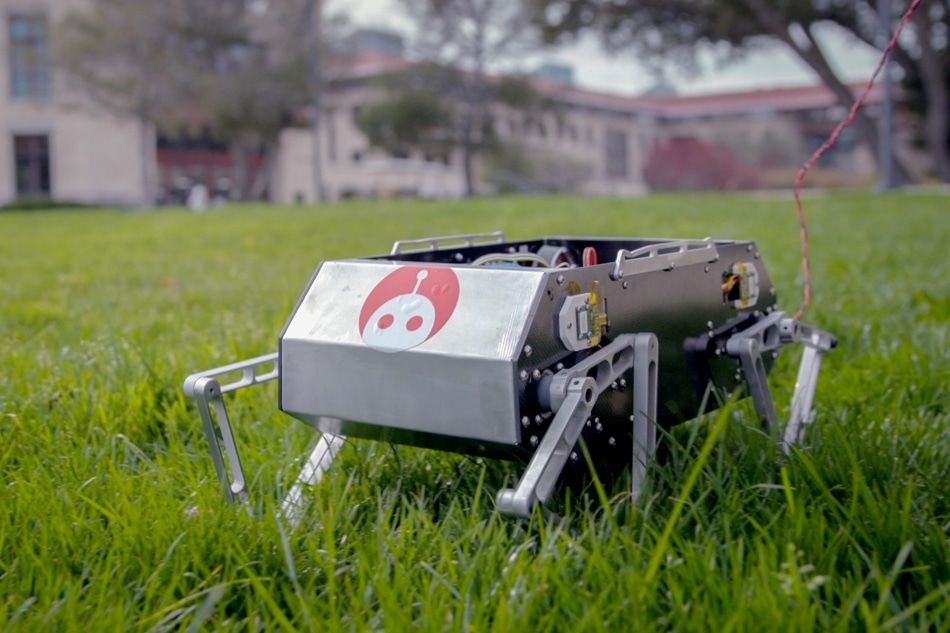May 21 2019
The Stanford Student Robotics club’s Extreme Mobility team at Stanford University has put its own twist on robots that stroll through intricate landscapes and has produced a four-legged robot that can not only carry out acrobatic tricks and travel through challenging terrain but is also developed with reproducibility in mind.
 Stanford students have developed Stanford Doggo, a relatively low-cost four-legged robot that can trot, jump and flip. (Image credit: Kurt Hickman)
Stanford students have developed Stanford Doggo, a relatively low-cost four-legged robot that can trot, jump and flip. (Image credit: Kurt Hickman)
Anybody who wishes to have their own version of the robot, known as Stanford Doggo, can check with comprehensive plans, code, and a supply list that the students have made freely available online.
We had seen these other quadruped robots used in research, but they weren’t something that you could bring into your own lab and use for your own projects. We wanted Stanford Doggo to be this open source robot that you could build yourself on a relatively small budget.
Nathan Kau, ’20, Mechanical Engineering Major and Lead for Extreme Mobility
While other comparable robots can cost tens or hundreds of thousands of dollars and need modified parts, the Extreme Mobility students estimate the cost of Stanford Doggo to be not more than $3000—including manufacturing and shipping costs—and almost all the components can be purchased online. They believe that the accessibility of these resources motivates a community of Stanford Doggo manufacturers and scientists who create innovative and significant spinoffs from their work.
Stanford Doggo can already trot, walk, hop, jump, dance, and do the occasional backflip. The students are working on a bigger version of their creation—which is currently about the size of a beagle—but will take a small break to exhibit Stanford Doggo at the International Conference on Robotics and Automation May 21 in Montreal, Canada.
A Hop, a Jump, and a Backflip
The students developed the Stanford Doggo from scratch in order to make it replicable. Due to this, a lot of time was spent studying easily achievable supplies and testing each part as they developed it, without depending on simulations.
It’s been about two years since we first had the idea to make a quadruped. We’ve definitely made several prototypes before we actually started working on this iteration of the dog. It was very exciting the first time we got him to walk.
Natalie Ferrante, ’19, Mechanical Engineering Co-Terminal Student and Extreme Mobility Team member
It is true that the first steps of Stanford Doggo were toddling; however, the robot can now maintain a steady gait and desired trajectory, even if it comes across various terrains. It achieves this by means of motors that sense external forces on the robot and establish how much force and torque each leg should apply in return. These motors recompute at 8000 times a second and are vital to the robot’s signature dance: a bouncy boogie that conceals the fact that it does not have springs. Rather, the motors function like a system of virtual springs, smoothly but perkily restoring the robot into correct structure whenever they sense that it is out of position.
Of the capabilities and tricks that were integrated into the robot’s repertoire by the team, the students were extremely stunned by its jumping ability. One (very) early morning in the lab, the team made Stanford Doggo run through its paces and they realized that it was effortlessly popping up 2 feet in the air. By pushing the boundaries of the robot’s software, Stanford Doggo gained the ability to jump 3 feet, and later 3½ feet, from the ground.
“This was when we realized that the robot was, in some respects, higher performing than other quadruped robots used in research, even though it was really low cost,” recalled Kau.
Since that time, the students have been training Stanford Doggo to perform a backflip, however always on padding to enable quick trial and error experimentation.
What will Stanford Doggo Do Next?
If these students could execute as intended, the future of Stanford Doggo is in the hands of the masses.
We’re hoping to provide a baseline system that anyone could build. Say, for example, you wanted to work on search and rescue; you could outfit it with sensors and write code on top of ours that would let it climb rock piles or excavate through caves. Or maybe it’s picking up stuff with an arm or carrying a package.
Patrick Slade, Graduate Student, Aeronautics and Astronautics, Stanford University
Slade is also a mentor for Extreme Mobility.
That does not imply that they are not continuing their own work. Extreme Mobility is joining hands with the Robotic Exploration Lab of Zachary Manchester, assistant professor of aeronautics and astronautics at Stanford, to test new control systems on a second Stanford Doggo. The team has also completed the construction of a robot that is twice the size of Stanford Doggo that can carry about 6 kg of equipment. It is known as Stanford Woofer.